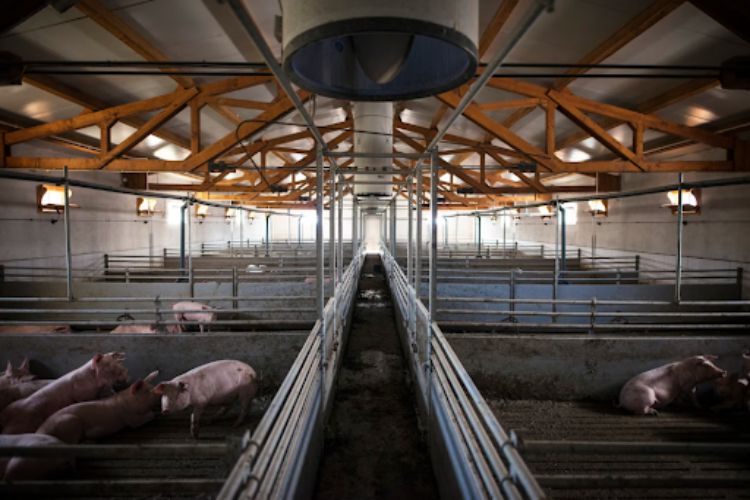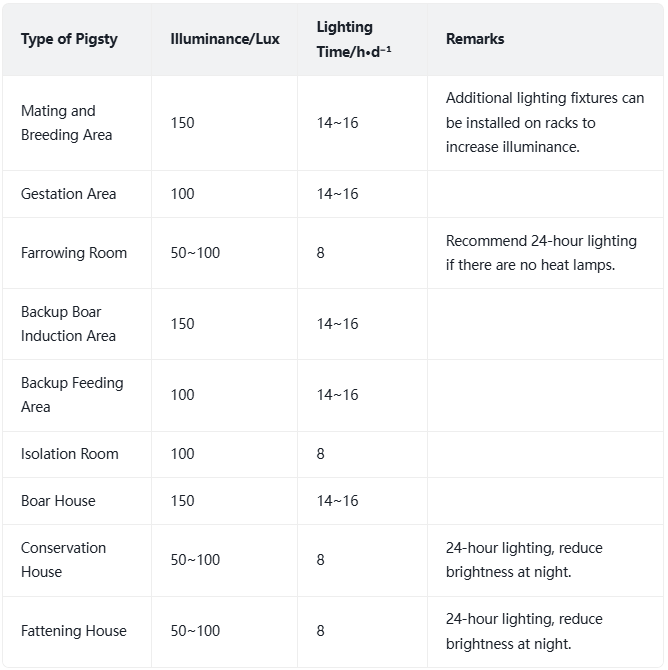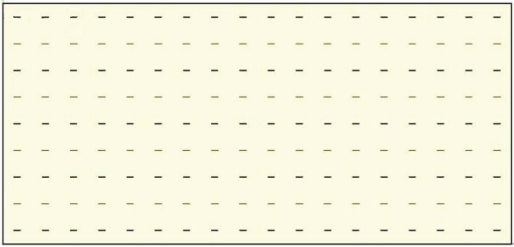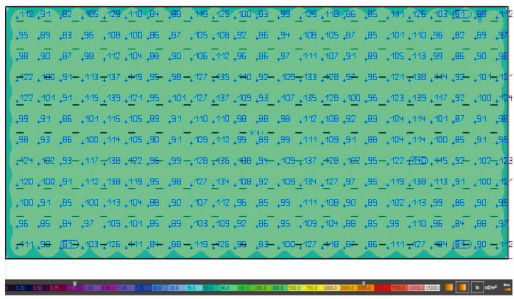Led Swine Lighting: The Application of Light Fixtures for Swine Barns

Directory:
1. Requirements for swine barns lighting fixtures
2. Illumination recommendations for swine barns
3. Method for Calculating Lighting Fixture Layout in swine Housing
In the modern swine farming industry, the airtightness of swine barns is crucial for the well-being of the swines. Swine barns that are well-sealed allow for manual control of ventilation speed and airflow. Conversely, poorly sealed swine barns have uncontrollable ventilation speeds and multiple air inlets, which can lead to "thief wind" and cold stress in swines, ultimately resulting in decreased production and financial losses.
Modern swine barns are designed to be highly airtight, with lighting primarily provided by fixtures within the barn. These swine lighting fixtures are essential as they can adjust brightness and color temperature in real-time to meet the biological needs of the swines. Proper lighting can stimulate estrus in sows, enhance the quality of boar semen, increase litter sizes, support swinelet growth, and contribute to health and sanitation, thereby improving the economic performance of swine farms.
1. Requirements for swine barns lighting fixtures
1.1 High light efficiency
Traditional incandescent bulbs have a light efficiency of 12 to 24 Lm/W, while T8 fluorescent and energy-saving lamps range from 50 to 60 Lm/W. In contrast, a single LED lamp bead can achieve over 160 Lm/W. Taking into account luminous flux loss, the overall light efficiency of finished LED fixtures should be at least 116 Lm/W.
1.2 High color rendering index
The color rendering index (CRI) measures a light source's ability to accurately represent the colors of objects compared to a reference light source of the same color temperature. The spectral content emitted by the light determines its color. If a light source lacks the necessary wavelengths to reflect an object's main colors, significant color discrepancies can occur. The CRI is a standard method for assessing this capability. Traditional incandescent bulbs have a CRI of 95 to 99. T8 fluorescent and energy-saving lamps around 70. while most LED products have a CRI above 80.
1.3 Wide Voltage Range
Farms are typically situated in remote locations with a weak power supply, and they contain various electrical equipment, particularly inductive loads like fans, which are frequently turned on and off. This results in numerous harmonics in the farm's power grid, leading to issues such as low power factor, inadequate or excessive voltage, and other power quality problems. Therefore, lighting products need to be capable of operating over a wide voltage range and possess some resistance to electromagnetic interference (EMC).
1.4 Low Light Decay
Light decay is a crucial factor in determining the lifespan of a product. Modern swine barns are usually designed to be closed, with lighting fixtures operating continuously for 24 hours. As a result, swine lighting products must exhibit low light decay to ensure that illumination levels remain adequate after 2 to 3 years of use. The standard requirement for light decay is 8.000 hours, with an ideal decay rate of no more than 5%. Products with a light decay exceeding 5% are not recommended for use in swine barns.
1.5 Corrosion Resistance
In swine barns, the waste produced by swines generates ammonia, hydrogen chloride, sulfide, carbon dioxide, methane, and other gases. This is particularly problematic in winter when ventilation is limited, leading to higher concentrations of harmful gases that can corrode lighting products, significantly reducing their lifespan or causing damage.
1.6 Protection Level IP67
Given the humid conditions in swine barns during summer, swine lighting products must have a protection rating of IP67. Without this level of protection, lighting fixtures may be damaged by water when the wet curtain is opened or when the barn is cleaned and disinfected.
2. Illumination recommendations for swine barns
Table 1 presents the standards set by the American Society of Agricultural Biological Engineers. As of 2018. the United States has the largest population of sows globally. The information in Table 1 reflects industry norms.
Table 1 American Society of Agricultural and Biological Engineers Standards

Note: The illuminance in the farrowing barn and nursery barn needs to be reduced at night.
Table 2 Domestic Swine Lighting Recommendations

Note: The illuminance measurement point is located at the swine head position, 0.4 ~ 0.5 m above the ground.
The lighting needs in the breeding area of the breeding barn, the boar barn, and the reserve barn are quite significant. This is primarily because strong lighting can encourage swines to come into heat and enhance breeding success rates. In contrast, the pregnant area of the breeding barn, the rear barn feeding area, and the isolation barn only require moderate lighting. In the farrowing barn, since sows and swinelets share the same farrowing bed, if a heat lamp is used for the swinelets, nighttime lighting can be eliminated. However, if the heat preservation equipment (like water heating boards or electric floor heating) does not provide light, then continuous lighting is necessary in the farrowing barn. The nursery and fattening barns do not need high light intensity, and lighting can be dimmed at night according to the daily schedule.
When constructing swine barns, large-scale swine farming companies in the country typically opt for closed structures to ensure optimal ventilation. Air enters the swine barn only through ceiling air inlet windows and wet curtains. The internal environmental conditions are managed by a preset intelligent environmental controller. During daily feeding, most of the light inside the swine barn comes from artificial lighting. If inappropriate lighting or incorrect light intensity is used, it can lead to abnormal behaviors in swines. Poor lighting can negatively impact the health, productivity, and welfare of the animals. Research indicates that proper use of lighting can help regulate swines' thermal functions, lower their energy consumption, decrease illness and mortality rates, reduce embryo loss during pregnancy, improve sow farrowing rates and the weight of newborn swinelets, and enhance feed conversion efficiency.
3. Method for Calculating Lighting Fixture Layout in swine Housing
3.1 Identify the Types of swine Housing and swines
Various swine housing types accommodate different swine breeds. For instance, sows in farrowing barns require illumination of 50-100 Lux, while sows in reserve housing need 100 Lux, and swinelets in nursery barns also need 50-100 Lux. It is essential to reduce brightness at night and return to normal levels during the day, as the light intensity varies for each swine type. Swine lighting fixtures should be arranged based on these specific requirements.
3.2 Understand the Actual Specifications of the Lighting Fixtures
The actual luminous flux and other specifications of the lighting products can be obtained from the product integrating sphere report provided by a third-party testing organization. With a wide variety of swine lighting fixtures available on the market, product quality can differ significantly. Comparative analysis and calculations indicate that the most cost-effective lighting investment for swine barns is achieved with fixtures rated at 25 W or higher.
3.3 Determine the Number and Arrangement of Lighting Fixtures for the Entire swine barn
DIALux is a specialized lighting design software that accommodates all types of lighting fixtures from manufacturers and fulfills current lighting design and calculation needs. The process begins by establishing the model parameters for the lighting fixtures, which includes arranging the fixtures, defining the space, placing doors and windows, positioning fences, and selecting materials. These model parameters are then imported into the software. For example, in a swine barn measuring 3060 m² (85 m long and 36 m wide), the simulation results generated by DIALux are illustrated in Figures 5-6. A total of 9 rows of lighting fixtures, each with a luminous flux of 2904 Lm, are utilized, comprising 18 lamps per row for a total of 162 lamps. The lighting system maintenance factor is set at 0.8. with 90% of the ground area achieving illumination levels of 90-130 Lux, and each lamp providing a luminous flux of 2904 Lm.
fig4 DIALux soft

fig5 Simulated layout of lamps

fig6 The software simulates the illumination at 0.5 m from the ground

This text summarizes a straightforward and practical empirical calculation method based on various real-world usage scenarios. Using a 1.2 m LED swine lighting fixture with a luminous flux of 2904 Lm as a model, the calculation is demonstrated with a barn area of 3060 ㎡. By dividing this area by empirical coefficients of 19 and 20. it is determined that the number of lighting fixtures needed is between 153 and 162. allowing for adjustments based on specific on-site requirements. Measurements taken at multiple swine farms, including Chunwan swine Farm in Yangchun City and Shuitai swine Farm in Yunfu City, showed actual illumination levels ranging from 90 to 115 Lux, aligning with the design expectations.
For lamps with different luminous flux values, similar calculations can be applied. For instance, with lamps providing 2.450 Lm, the required number of fixtures in the same swine barn would be calculated as (3.060×3.060/2.450)/19=201.1 and (3.060×3.060/2.450)/20=191. rounding up to suggest a need for 192 to 202 lamps.
As the primary light source in modern swine barns, the demand for specialized lighting solutions is increasing due to the need for refined feeding practices and the implementation of national energy-saving and environmental measures. However, there is currently a lack of clarity regarding product demand across various swine farms, leading to inconsistent lighting solutions and potential safety hazards with existing lamps. Drawing from the author's extensive experience in field equipment, this article outlines the technical requirements for product use, offers a simple algorithm for lighting fixture layout in domestic swine farming, and provides guidance for determining relevant lighting fixture indicators.
4. Related Products
4.1 Swine lights T21

4.2 Swine lights T16

5. Related Solution & Science
6. Related Blog
Pig Farms Lighting Design: Best Light for Pig House
7. Contact Ceramiclite
